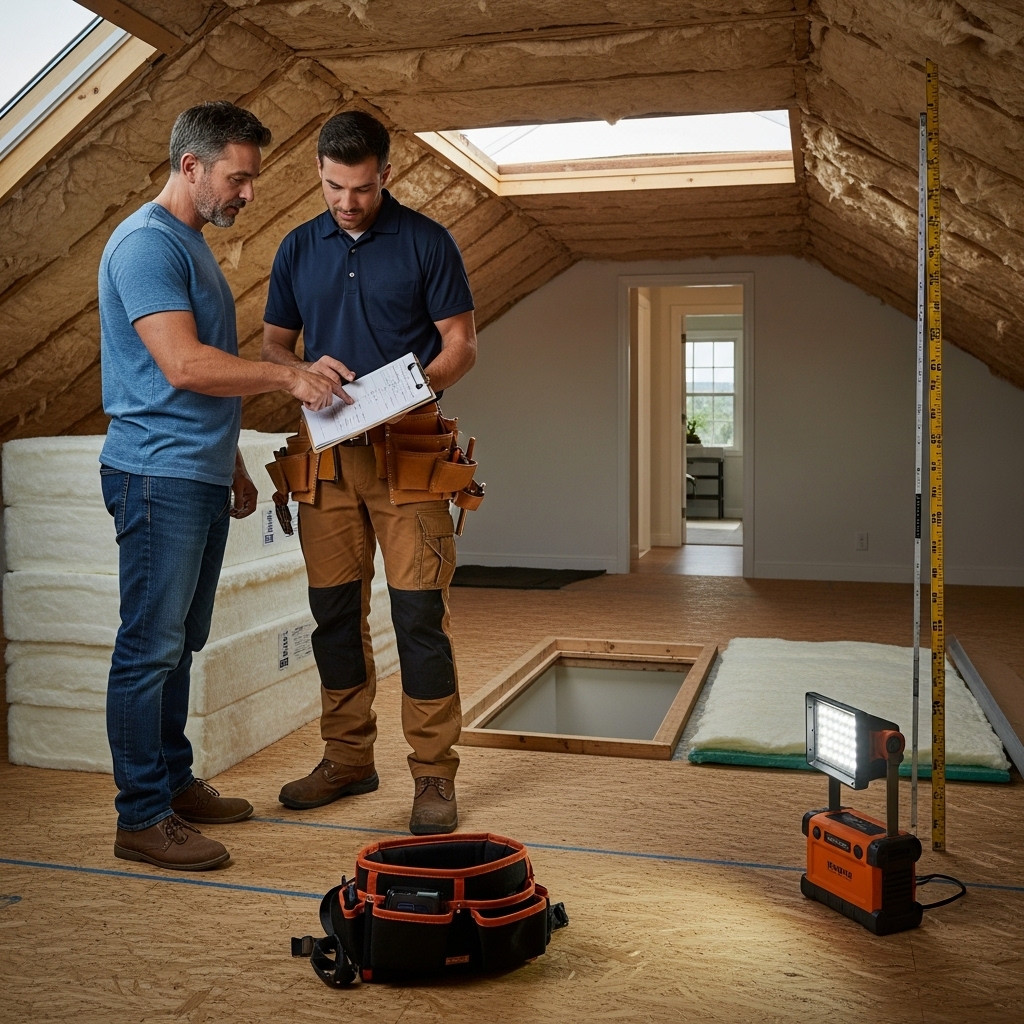Planning an attic upgrade in Los Angeles involves more than choosing a material and scheduling a crew. To make confident, informed decisions, you need to understand the factors that shape the overall investment, the line items that belong in a comprehensive proposal, and the common pitfalls that lead to disappointing results. This guide lays out a clear framework you can use to evaluate proposals, anticipate scope, and align expectations—without guesswork. Early in your research, remember that a professional approach to attic insulation treats your home as a system, addressing air sealing, ventilation, and clean installation practices alongside the insulation itself.
While every home is unique, you can predict the parts of the job that are most likely to influence time, materials, and complexity. By learning the language of a complete attic project and how each step adds value, you can compare proposals fairly and choose the team that delivers comfort, durability, and performance.
Key Drivers of Your Attic Upgrade
Several elements shape the scale of an attic project. Understanding them will help you interpret proposals and ask smart follow-up questions:
- Home size and layout: Larger attics or multiple attic bays require more material and labor attention, especially around transitions and partitions.
- Access and clearance: Tight hatches, steep pitches, or low eaves increase the care and time needed for even coverage and safe movement.
- Existing conditions: Clean, dry insulation may be augmented, while contaminated or uneven material often calls for removal and reinstallation.
- Air leakage severity: The number and size of penetrations through the attic floor (top plates, plumbing stacks, wiring, open chases) determine the scale of air sealing work.
- Ventilation balance: Adding or clearing soffits and adjusting exhaust improves thermal performance and protects roof assemblies.
- Ductwork condition: Leaky, uninsulated, or crushed ducts undermine comfort; addressing them during the project amplifies results.
- Material selection: Blown-in fiberglass, cellulose, batt systems, or roofline foam each carry different installation methods and prep requirements.
These drivers interact. For example, an attic with limited access and extensive air leaks might require careful staging, more time on sealing, and additional protective measures for your living area.
Scope Elements That Add Real Value
Homeowners often focus on insulation thickness or product labels, but the biggest performance gains come from a complete scope. Look for the following elements in your proposal:
- Air sealing plan: Specific locations to be sealed and the materials used (e.g., sealant types, rigid blocking for large gaps, hatch gaskets).
- Ventilation adjustments: Clearing soffit vents, verifying baffles, and ensuring balanced intake and exhaust.
- Fixture treatments: Covers and clearances for recessed lighting, proper shielding around flues and chimneys, and safe wiring considerations.
- Even coverage strategy: How the crew will achieve uniform depth at eaves, around truss webs, and near obstructions.
- Dust control and containment: Protection for living areas, pathway coverings, and clean-up procedures.
- Waste handling: Method for removing deteriorated or contaminated insulation if needed, including bagging and disposal.
- Documentation: Before-and-after photos and a post-install walkthrough to confirm the work matches the plan.
A proposal that includes these items—even if it’s more detailed—usually reflects a team that understands building science and respects your home.
Material Choices and Their Implications
Each insulation type brings different installation practices and benefits. The best choice depends on your attic’s geometry, ventilation strategy, and goals for comfort and air quality:
- Blown-in fiberglass: Provides resilient performance and coverage, especially in open attics with varied framing.
- Cellulose: Fills irregular spaces and offers sound control; treated for fire resistance, it can be dense-packed in certain applications to reduce air movement within cavities.
- Batt systems: Good for accessible areas like knee walls when installed with precision around wiring and plumbing.
- Roofline foam assemblies: Combine insulation and air sealing at the roof deck for unvented attics; strict prep, ventilation planning, and experienced crews are essential.
- Radiant barriers: A supplemental measure under roof decking to reduce radiant gain in sunny climates when designed into a balanced attic strategy.
Material choice should be framed as part of a system, not a one-solution-fits-all decision. Ask how each option affects ventilation needs, air sealing priorities, and long-term maintenance.
Understanding Attic Removal and Remediation
Removal is recommended when existing insulation is wet, pest-contaminated, heavily compressed, or hiding significant air pathways. Safe removal includes containment at the hatch, bagging debris at the source, and HEPA filtration to protect indoor air. If rodent remediation is necessary, your contractor should coordinate sanitation steps and sealing of entry points before reinstalling new materials. Removal is also an opportunity to seal hidden penetrations that would otherwise remain buried.
Air Sealing: The Invisible Work with Visible Results
Because heat and pollutants move with air, sealing the attic floor often delivers immediate comfort gains. Expect targeted sealing at top plates, wire penetrations, plumbing stacks, dropped soffits, open chases, and the attic hatch. For recessed lights and flues, safe clearances and approved covers are critical. When this work is done carefully, your insulation performs to its potential, reducing hot spots and evening out room-to-room temperatures.
Ventilation: Balancing Intake and Exhaust
In Los Angeles, balanced airflow through the attic protects roof assemblies and limits heat buildup. Clearing soffit vents, adding baffles, and ensuring compatible exhaust are core tasks. Without intake, exhaust alone can create negative pressure that pulls conditioned air from your living spaces; without exhaust, heat accumulates and stresses the roof deck. Your proposal should describe how the crew will confirm and maintain the balance.
Ductwork Considerations
Attic ducts influence comfort and energy performance. During an insulation upgrade, it’s wise to inspect, seal, and support duct runs. Reducing leakage prevents conditioned air from spilling into the attic and keeps attic air from being drawn into your supply. A small investment of attention here can unlock some of the biggest comfort gains from the entire project.
Comparing Proposals Fairly
To evaluate multiple firms, align their scopes and look for concrete details. Insist on a list of air sealing locations, a ventilation plan, fixture treatments, and a coverage strategy. Clarify assumptions around removal and cleanup. A thorough approach to attic insulation should be explained step by step, with photos of similar projects and a commitment to documenting your job from start to finish.
Myths to Avoid
Several misunderstandings can derail smart decision-making:
- “Insulation alone solves everything.” Without air sealing, you can still experience drafts, dust, and uneven temperatures.
- “More is always better.” Coverage quality, eave detailing, and ventilation balance matter just as much as depth.
- “All materials are the same.” Each has different installation methods, moisture behavior, and compatibility with your attic’s layout.
- “Ventilation doesn’t matter in LA.” It does—balanced ventilation protects roof assemblies and stabilizes attic conditions across microclimates.
Project Timeline and Logistics
Project duration varies with attic size, access, removal needs, and sealing complexity. Crews protect pathways, set up containment, and stage equipment to minimize disruption. A good contractor communicates daily milestones and any discoveries that could affect the plan, such as a blocked soffit line or an unexpected open chase behind a wall.
Health, Safety, and Cleanliness
Professional teams protect occupants with dust containment, careful handling of legacy debris, and HEPA filtration if removal is performed. They maintain clearances around heat sources, respect electrical safety, and keep your living areas clean. After the job, expect a thorough cleanup, vacuumed registers, and reinstalled hatch gaskets for an airtight seal.
What Belongs in Your Proposal Checklist
Use this checklist to review each proposal:
- Detailed attic assessment with photos.
- Specific air sealing plan and materials.
- Ventilation adjustments and baffle details.
- Treatment plan for recessed lights and flues.
- Even coverage method for eaves and obstructions.
- Removal methodology if applicable.
- Dust containment and cleanup process.
- Documentation and walkthrough commitments.
- Warranty terms and point of contact for follow-up.
When each contractor answers these points, you can judge the completeness of the approach and anticipate the experience you’ll have during installation.
Neighborhood and Home-Style Considerations
Spanish-style bungalows, post-war ranches, hillside homes with split levels, and newer construction each present unique attic conditions. For example, homes with limited soffit overhangs require extra attention to eave baffles and wind-wash protections, while hillside homes may have multiple mini-attics separated by partition walls. A seasoned crew will tailor methods to these realities and explain the reasoning behind every step.
Aftercare and Future Projects
Insulation upgrades perform best when you protect the air barrier over time. If you plan new recessed lights, additional wiring, or roof work, keep your documentation handy and coordinate with professionals to maintain clearances and seal any new penetrations. Periodic visual checks of vents and hatches help preserve the system’s integrity.
FAQ: Planning Your Attic Upgrade
Q: Is removal always necessary before adding new material?
A: No. Removal depends on contamination, moisture history, and the ability to perform proper air sealing. Clean, dry, evenly distributed insulation can sometimes be augmented.
Q: Will I need to be home during the project?
A: It helps to be available for the initial walkthrough and final review. During installation, crews can work independently while keeping you updated on progress and any findings.
Q: How do I know if my attic is ventilated correctly?
A: A professional will verify clear intake at soffits, check baffles, and confirm compatible exhaust. They’ll also look for signs of heat or moisture issues on the roof deck and insulation surface.
Q: Can insulation help with noise?
A: Yes. Dense materials and uniform coverage reduce sound transmission from outside and between rooms, contributing to a quieter home.
Q: What should I expect on installation day?
A: Protective coverings, containment at the hatch, methodical air sealing, careful application of insulation, and a thorough cleanup. The team should provide updates and invite questions.
Q: How do I compare multiple proposals effectively?
A: Align scopes using the checklist above. Ensure each contractor addresses air sealing, ventilation, fixture treatments, coverage strategies, and documentation.
Q: Will this help my HVAC system?
A: Yes. By stabilizing attic temperatures and reducing leakage, your HVAC works less hard, often cycling more gently and evenly.
Move Forward with Confidence
A well-planned attic upgrade is one of the most effective ways to improve comfort in Los Angeles homes. Focus on scope quality, clean techniques, ventilation balance, and precise air sealing. Ask every contractor to explain their reasoning and show photos from similar projects. When you’re ready to explore options, look for a team that treats attic insulation as part of a whole-home strategy and offers clear documentation, respectful service, and reliable aftercare. With the right partner, your attic can become a quiet, protective barrier that supports healthy air and year-round comfort.

